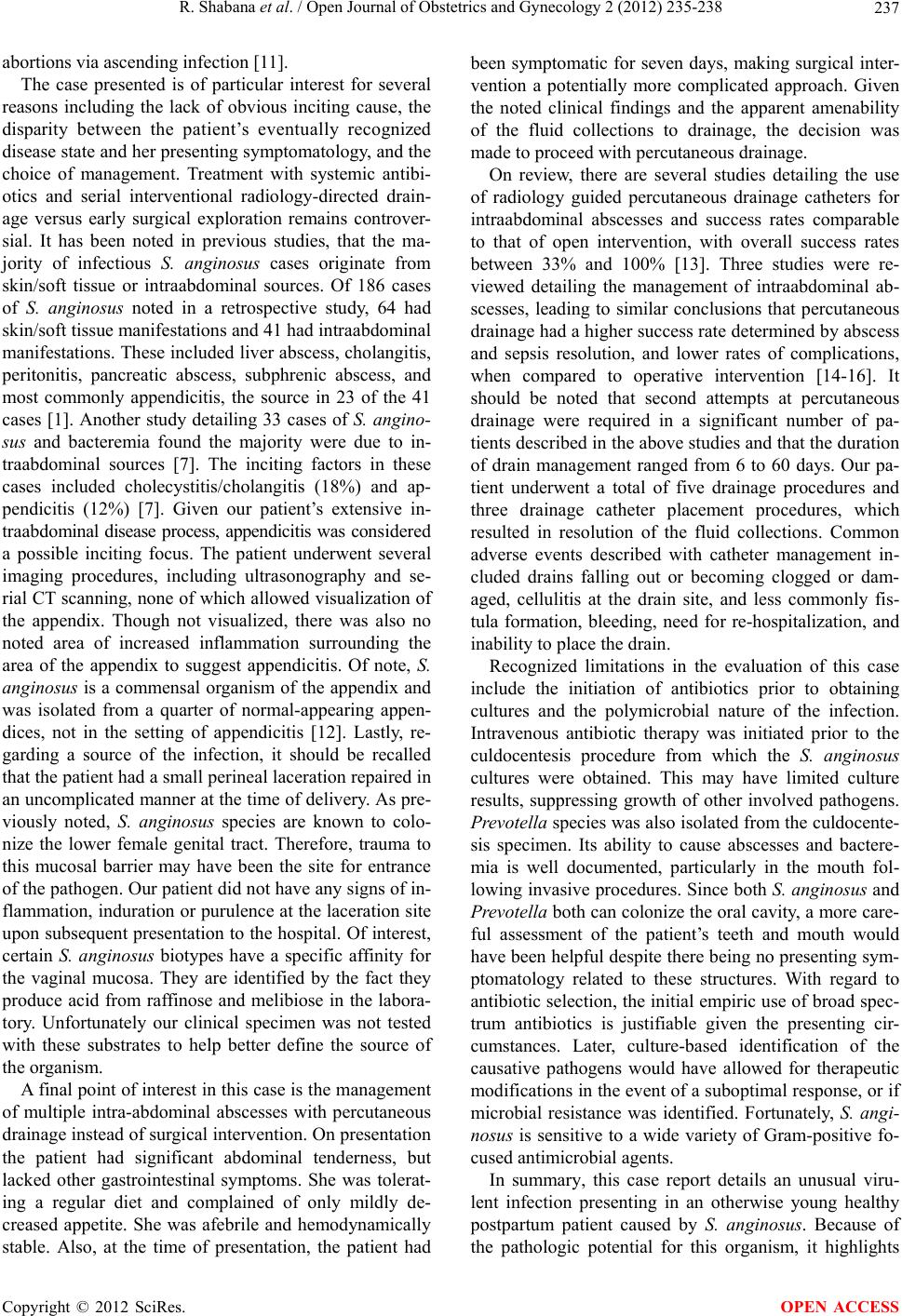
R. Shabana et al. / Open Journal of Obstetrics and Gynecology 2 (2012) 235-238 237
abortions via ascending infection [11].
The case presented is of particular interest for several
reasons including the lack of obvious inciting cause, the
disparity between the patient’s eventually recognized
disease state and her presenting symptomatology, and the
choice of management. Treatment with systemic antibi-
otics and serial interventional radiology-directed drain-
age versus early surgical exploration remains controver-
sial. It has been noted in previous studies, that the ma-
jority of infectious S. anginosus cases originate from
skin/soft tissue or intraabdominal sources. Of 186 cases
of S. anginosus noted in a retrospective study, 64 had
skin/soft tissue manifestations and 41 had intraabdominal
manifestations. These in cluded liver abscess, cho langitis,
peritonitis, pancreatic abscess, subphrenic abscess, and
most commonly appendicitis, the source in 23 of the 41
cases [1]. Another study detailing 33 cases of S. angino-
sus and bacteremia found the majority were due to in-
traabdominal sources [7]. The inciting factors in these
cases included cholecystitis/cholangitis (18%) and ap-
pendicitis (12%) [7]. Given our patient’s extensive in-
traabdominal disease process, appendicitis was considered
a possible inciting focus. The patient underwent several
imaging procedures, including ultrasonography and se-
rial CT scanning, none of which allowed visualization of
the appendix. Though not visualized, there was also no
noted area of increased inflammation surrounding the
area of the appendix to suggest appendicitis. Of note, S.
anginosus is a commensal organism of the appendix and
was isolated from a quarter of normal-appearing appen-
dices, not in the setting of appendicitis [12]. Lastly, re-
garding a source of the infection, it should be recalled
that the patient had a small perineal laceration repaired in
an uncomplicated manner at the time of delivery. As pre-
viously noted, S. anginosus species are known to colo-
nize the lower female genital tract. Therefore, trauma to
this mucosal barrier may have been the site for entrance
of the pathogen. Our patient did not have any signs of in-
flammation, induration or purulence at the laceration site
upon subsequent presen tation to the hospital. Of interest,
certain S. anginosus biotypes have a specific affinity for
the vaginal mucosa. They are identified by the fact they
produce acid from raffinose and melibiose in the labora-
tory. Unfortunately our clinical specimen was not tested
with these substrates to help better define the source of
the organism.
A final point of interest in this case is the manage ment
of multiple intra-abdominal abscesses with percutaneous
drainage instead of surgical intervention. On presentatio n
the patient had significant abdominal tenderness, but
lacked other gastrointestinal symptoms. She was tolerat-
ing a regular diet and complained of only mildly de-
creased appetite. She was afebrile and hemodynamically
stable. Also, at the time of presentation, the patient had
been symptomatic for seven days, making surgical inter-
vention a potentially more complicated approach. Given
the noted clinical findings and the apparent amenability
of the fluid collections to drainage, the decision was
made to proceed wit h percutaneous drai na ge.
On review, there are several studies detailing the use
of radiology guided percutaneous drainage catheters for
intraabdominal abscesses and success rates comparable
to that of open intervention, with overall success rates
between 33% and 100% [13]. Three studies were re-
viewed detailing the management of intraabdominal ab-
scesses, leading to similar conclusions that percutaneous
drainage had a higher success rate determined by abscess
and sepsis resolution, and lower rates of complications,
when compared to operative intervention [14-16]. It
should be noted that second attempts at percutaneous
drainage were required in a significant number of pa-
tients described in the above studies and that the duration
of drain management ranged from 6 to 60 days. Our pa-
tient underwent a total of five drainage procedures and
three drainage catheter placement procedures, which
resulted in resolution of the fluid collections. Common
adverse events described with catheter management in-
cluded drains falling out or becoming clogged or dam-
aged, cellulitis at the drain site, and less commonly fis-
tula formation, bleeding, need for re-hospitalization, and
inability to place the drain.
Recognized limitations in the evaluation of this case
include the initiation of antibiotics prior to obtaining
cultures and the polymicrobial nature of the infection.
Intravenous antibiotic therapy was initiated prior to the
culdocentesis procedure from which the S. anginosus
cultures were obtained. This may have limited culture
results, suppressing growth of other involved pathogens.
Prevotella species was also isolated from the culdocente-
sis specimen. Its ability to cause abscesses and bactere-
mia is well documented, particularly in the mouth fol-
lowing invasive proc edures. Since both S. anginosus and
Prevotella both can colonize the oral cavity, a more care-
ful assessment of the patient’s teeth and mouth would
have been helpful despite there being no presenting sym-
ptomatology related to these structures. With regard to
antibiotic selection , the initial empiric use of broad spec-
trum antibiotics is justifiable given the presenting cir-
cumstances. Later, culture-based identification of the
causative pathogens would have allowed for therapeutic
modifications in the event of a suboptimal response, or if
microbial resistance was identified. Fortunately, S. angi-
nosus is sensitive to a wide variety of Gram-positive fo-
cused antimicrobial agents.
In summary, this case report details an unusual viru-
lent infection presenting in an otherwise young healthy
postpartum patient caused by S. anginosus. Because of
the pathologic potential for this organism, it highlights
Copyright © 2012 SciRes. OPEN ACCESS